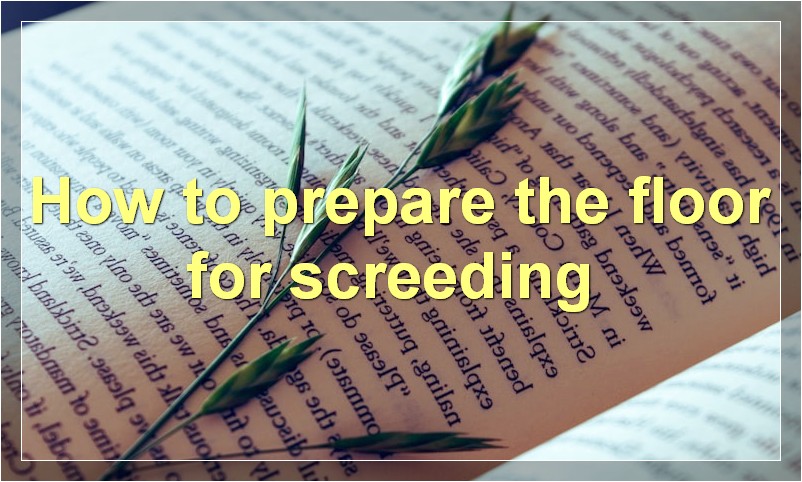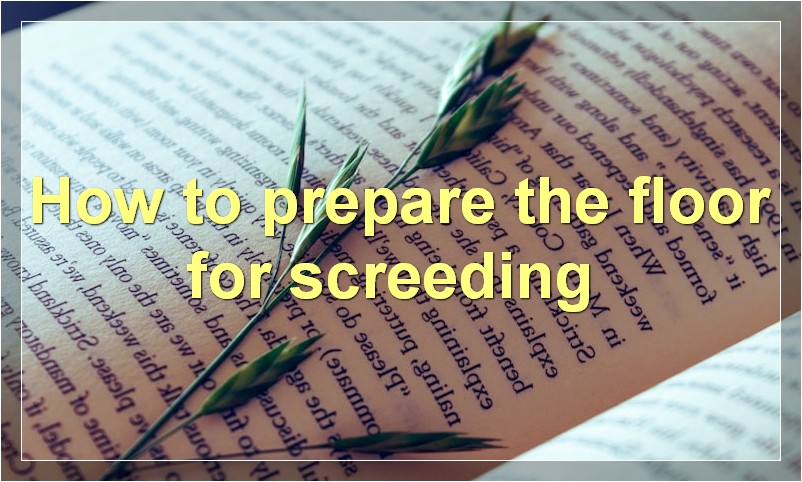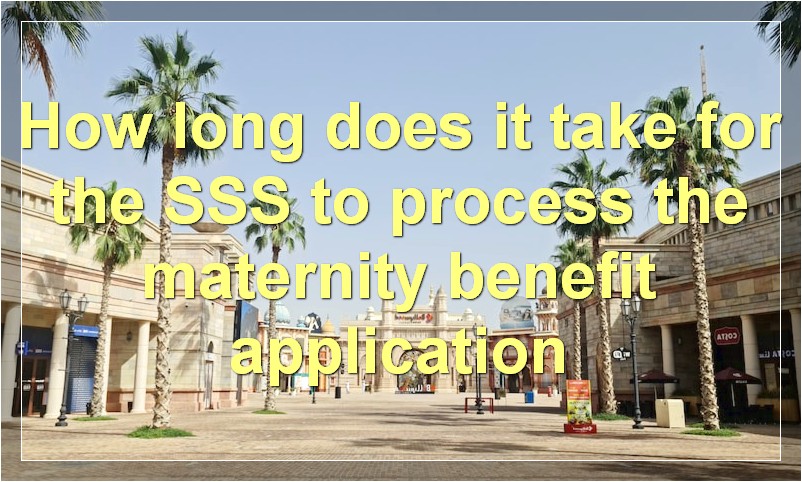Are you looking for a professional-grade finish for your flooring project? If so, then you need to learn how to screed a floor. Screeding is a process of leveling and smoothing concrete surfaces using a long, straight edge. It’s an important step in creating a level foundation for floors, driveways, patios, and other concrete surfaces.
How to level a floor before screeding?
Leveling a floor is an important step in the process of screeding. If the floor is not level, the screed will not be level and the finished product will be uneven. There are a few different ways to level a floor before screeding.
The first way is to use a laser level. This is a tool that projects a laser beam onto the floor. The beam is used as a guide to make sure the floor is level.
Another way to level a floor is to use a long level. This is a tool that is placed on the floor and used to check if the floor is level. It is important to make sure that the long level is placed in the middle of the room so that it can be used as a reference point for the rest of the room.
The last way to level a floor is to use shims. Shims are thin pieces of wood or metal that are placed under one side of the long level to make it level. This method is usually used when the floor is not even close to being level.
Once the floor is level, it is time to start screeding. Screeding is the process of spreading concrete or mortar over the surface of the floor. The concrete or mortar is then leveled with a straight edge or trowel.
How to prepare the floor for screeding?

Preparation of the floor prior to screeding is extremely important in order to achieve a good, level finish. The following guide outlines the necessary preparation required in order to ensure a successful outcome.
The first step is to clear the floor of any debris or objects which may be present. This includes any furniture, carpets or rugs which may be covering the floor. Once the floor is clear, it should be vacuumed thoroughly in order to remove any dust or dirt which may be present.
The next step is to fill any cracks or holes which may be present in the floor. This can be done using a suitable filler such as polyfilla. Once the filler has dried, the floor should be sanded down in order to create a smooth surface.
Once the floor is prepared, it is now time to start screeding. The first thing to do is to mix the screed according to the manufacturer’s instructions. Once mixed, the screed can then be spread onto the floor using a suitable trowel.
It is important to ensure that the screed is spread evenly across the floor and that there are no low or high spots. Once the screed has been spread, it should be left to dry for the amount of time specified by the manufacturer. Once dry, the floor is now ready for use.
What is the best way to screed a floor?
When it comes to screeding a floor, there are a few different methods that can be used. The best way to screed a floor will depend on the type of flooring that you have, as well as the surface that you are working with. For example, if you have a concrete floor, then using a power trowel is going to be the best way to go. However, if you have a wooden floor, then using a hand-held tool is going to be the best option.
No matter what type of flooring you have, the first step is always going to be to prepare the surface. This means that you will need to make sure that the area is clean and free of any debris. Once the surface is prepped, you can then start to work on screeding the floor.
If you are using a power trowel, then you will want to start in one corner and work your way out. You will want to hold the trowel at a slight angle and move it across the floor in a sweeping motion. As you are doing this, you will want to make sure that you are applying even pressure.
If you are using a hand-held tool, then you will want to start in one corner and work your way out. You will want to hold the tool at a slight angle and move it across the floor in a sweeping motion. As you are doing this, you will want to make sure that you are applying even pressure.
Once you have finished screeding the floor, you will then need to allow the area to dry. This process can take anywhere from 24 to 48 hours, depending on the temperature and humidity levels in the room. Once the area is completely dry, you can then proceed to install your new flooring.
How much does it cost to screed a floor?
When it comes to screeding a floor, the cost will vary depending on a number of factors. The type of floor you have, the size of the room, the complexity of the job and the location all play a role in how much you can expect to pay.
If you’re looking for a quick and easy answer, you can expect to pay between £100 and £200 per square metre for most types of floor screeding. However, if you have a more complex job or a larger room, the price can go up to £300 per square metre.
Of course, these prices are just a rough guide. To get an accurate quote for your project, it’s always best to get in touch with a professional screeding company.
So, how much does it cost to screed a floor? It really depends on a number of factors. But if you’re looking for a quick answer, you can expect to pay between £100 and £200 per square metre.
How to get a smooth finish when screeding a floor?
When screeding a floor, the key to getting a smooth finish is all in the prep work. If the surface beneath the screed is uneven, then the screed will reflect that. So, before you even think about starting to lay down your screed, make sure that the surface is as level as possible.
Once the surface is prepped and ready to go, you can start mixing up your screed. If you’re using a premixed screed, then simply follow the manufacturer’s instructions. But if you’re mixing your own, then there are a few things to keep in mind.
First, use clean water. Second, make sure that the ratio of cement to sand is correct. Too much cement and the mix will be difficult to work with; too much sand and it will be too loose. Third, add enough water so that the mix is wet but not soupy.
Once your screed is mixed, it’s time to start laying it down. Starting at one end of the room, pour out a small amount of screed and spread it evenly with a trowel. Work in small sections, moving along the floor until you’ve covered the entire area.
As you’re spreading the screed, be sure to keep an eye on the thickness. You want it to be about an inch thick, give or take a quarter of an inch. Any thicker than that and it will be difficult to level off; any thinner and it will be susceptible to cracking.
Once you’ve got the entire floor covered, use a long straightedge to level off the screed. Hold one end of the straightedge at one end of the room and sight down it to check for low spots. When you find a low spot, mark it with chalk so you’ll know where to come back and add more screed.
Once all the low spots have been filled in and the surface is nice and level, allow the screed to cure for at least 24 hours before walking on it or adding any flooring over top. And that’s all there is to getting a smooth finish when screeding a floor!
What tools do I need to screed a floor?

A level, a straight edge, a sharp knife and a good trowel are the tools you need to screed a floor.
How long does it take to screed a floor?
If you’re planning on screeding a floor, you might be wondering how long the process will take. Screeding is an important step in laying a new floor, and it’s important to do it right. Here’s a look at how long it takes to screed a floor, and what you need to know to get the job done right.
Screeding is the process of leveling and smoothing out concrete before it dries. It’s an important step in laying a new concrete floor, and it’s important to do it right. If you don’t, you could end up with a floor that’s not level, which can cause all sorts of problems down the line.
So how long does it take to screed a floor? The answer depends on a few factors, including the size of the area you’re working with and the thickness of the concrete. Generally speaking, though, you can expect to spend about 30 minutes per square meter when screeding a floor.
Of course, that’s just an estimate. The actual time will vary depending on the circumstances. If you’re working with a large area or thick concrete, it will take longer. If you’re working with a small area or thin concrete, it will take less time.
In any case, it’s important to take your time when screeding a floor. rushing the job will only lead to problems. So set aside enough time to do it right, and you’ll end up with a beautiful new floor that you can be proud of.
Is it easy to screed a floor?
“Screeding” a floor is the process of leveling and smoothing concrete before it dries. The goal is to create a flat surface with a consistent thickness. Screeding is an important step in the concrete-laying process, and there are a few different ways to do it.
One common method is to use a long straightedge or “screed board.” This board is placed on top of the wet concrete and pulled along the length of the floor. As it’s pulled, the board levels off the surface of the concrete.
Another popular method is to use a power screed. This machine has a vibrating blade that levels and smooths the concrete as it moves along. Power screeds are faster and easier to use than screed boards, but they can be more expensive.
Screeding is a relatively easy process, but it’s important to do it right. If the concrete isn’t level or smooth, it can cause problems later on. So take your time, and make sure the surface is as flat and even as possible.
What are the benefits of screeding a floor?
When it comes to creating a level surface for laying flooring, screeding is often the best option. Not only is it quick and easy to do, but it also offers a number of benefits that other methods simply can’t match. Here are just four of the many reasons why you should consider screeding your floor before laying your new flooring.
A level surface is essential for any kind of flooring
Whether you’re laying carpet, vinyl, tiles or anything else, it’s important to have a completely level surface. Even the slightest unevenness can cause problems, such as tiles lifting or cracking, carpet buckling or vinyl bubbles. Screeding creates a perfectly level surface, so you can be confident that your new flooring will be installed correctly.
Screeding is fast and easy
Compared to other methods of creating a level surface, screeding is extremely quick and easy. It can often be done in a matter of hours, which means you can get on with installing your new flooring much sooner. This is particularly important if you’re on a tight deadline or need to keep disruptions to a minimum.
Screeding provides a strong foundation
A well-screeded floor will provide an extremely strong foundation for your new flooring. This is because screed contains cement, which dries hard and durable. This will help to extend the lifespan of your flooring and prevent problems such as sagging or indentations.
Screeding gives you more design options
If you’re laying flooring in an area where there may be potential for moisture, such as a bathroom or kitchen, screeding provides you with more design options. This is because screed can be used with underfloor heating, which isn’t possible with other methods of creating a level surface. Underfloor heating not only looks great, but it’s also an extremely efficient way to heat your home.
Why is it important to screed a floor?
When you are screeding a floor, you are creating an even surface that is level and smooth. This is important because it provides a stable foundation for the flooring that will be installed on top of it. If the surface is not level or smooth, the flooring could be uneven and look unsightly. Screeding also helps to ensure that the flooring will last longer, as it will be less likely to crack or become damaged if it is laid on a level surface.




